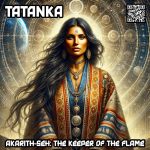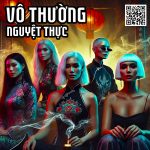Downloads (FREE): MP3 (320kbps), FLAC (Lossless), MP4 (1080p)
“Experience life in all possible ways—good-bad, bitter-sweet, dark-light, summer-winter. Experience all the dualities. Don’t be afraid of experience.”
— Osho
goodreads.com
Google’s Deep Dive Podcast: Neon Kabuki: The Cyberpunk Alchemy of Tradition and Rebellion
Ancient Grace Meets Futuristic Rebellion in a Lyrical Dreamscape
In a world where past and future collide, Neon Kabuki emerges as a sonic and visual odyssey—a poetic fusion of ancient beauty and cyberpunk defiance. Dripping in electric mystique, the song embodies the tension between tradition and transformation, divine feminine and masculine, elegance and chaos.
With echoes of Blade Runner’s neon-drenched dystopia and the hypnotic allure of traditional Geisha artistry, Neon Kabuki is more than a song; it is a myth reborn, a fever dream set to music. Lyrically cryptic yet evocative, its verses paint a world where serpents hum truth, shadows weave need, and primal forces battle against infinite ambition. This is a tale of metamorphosis—of lovers, rebels, and dreamers navigating the twilight between past and possibility.
As the track unfolds, Neon Kabuki challenges the listener to embrace paradox: to find power in fragility, revolution in grace, and meaning in the surreal. In this deep dive, we explore the themes, sonic textures, and poetic intricacies that make Neon Kabuki a mesmerizing experience—a bridge between worlds both ancient and yet to come.
Song/Lyrics
Song Style: Traditional Geisha fused with avant-garde, experimental. Divine feminine & divine masculine, a Yin-Yang. Futuristic rebellion + ancient beauty. Dichotomous,androgynous, transformative, mysterious.
Themes: Blade Runner vibe. Duality, sexuality, transformation—futuristic rebellion meets ancient grace. Mystique and power collide, neon-drenched chaos, timeless stories echo with hot, cyberpunk intensity.
Lyrics:
[Verse]
Fate struck my eyes true
Kaleidoscope sunset
Time rang fire new
Kohl for Adam
[Verse]
And cobras bleed songs
Past batteries
Amber rush regions
And Diosa speak sex
Yes
[Chorus]
Lithe savages set
Upon rough, angry lovers
Above primal razors
And infinite ambitions
[Verse]
Mythos is gauze-wrap-torqued marble at midnight
Waterless torture and thin-stretched nightshade wine
Infinite elegance live in you war one
Underground glamour leap into moon man
[Chorus]
Lithe savages set
Upon rough adept lover
Above narrow fierce
And fearsome ambitions
[Verse]
Mythos is gauze-wrap-torqued marble at midnight
Waterless torture and thin-stretched nightshade wine
[Verse]
Infinite elegance live in you war one
Underground glamour leap into moon man
Burning wide-time light
Flames upon my chest
My darling sexequitie
My mythos best
[Intro]
Echoes in twilight
Kaleidoscope sunset bleed
Where serpents hum truth
And shadows weave need
[Verse]
Fate struck my eyes true
Kaleidoscope sunset
Time rang fire new
Adam, meet Eve
[Verse]
And cobras bleed songs
Past batteries
Amber rush regions
And Diosa speak sex
Yes, yes, yes.
[Chorus]
Lithe savages set
Upon rough, angry lovers
Above primal razors
And infinite ambitions
[Verse]
Mythos is gauze-wrap-torqued marble at midnight
Waterless torture and thin-stretched nightshade wine
Infinite elegance live in you war-fuck one
Underground glamour leap into moon man
[Verse]
Burning wide-time light
Flames upon my chest
My darling sexequitie
My mythos best
[Verse]
Silhouettes coil near
Dreams draped in chrome lace
Future’s tongue dances
On forgotten places
[Verse]
Echoes breathe heavy
Through neon-lit caves
Savage hearts hunger
Where gender blurs and braves
[Chorus]
Lithe savages set
Upon rough adept lover
Above narrow fierce
And fearsome ambitions
[Bridge]
Whispers of dusk’s flame
In chaos we trust
Shadows consume grace
Yet diamonds find dust
[Verse]
Infinite elegance live in you war-fuck two
Underground glamour leap into moon eunuch
Embers grip my bones
Cinders whisper loud
Eons split open
Unravel the shroud
[Verse]
Ravenous sirens sing
In liquid sapphire skies
Gaze sharp as sin’s blade
Eyes ancient and wise
Open me, all of me
Lay me to waste not
[Chorus]
Lithe savages set
Upon rough adept lover
Above narrow fierce
And fearsome ambitions
[Chorus]
Lithe savages set
Upon rough adept lover
Above narrow fierce
And fearsome ambitions
[Outro]
Time’s echo fades slow
Through dust and desire
My mythos remains
In shadows of fire
Neon Reverie: The Symphony of Saffron Skies

The city pulsed in electric hues—violet streaks across a smog-stained sky, neon kanji flickering like celestial messages lost in time. Beneath the holographic billboards and the weight of a thousand unseen eyes, Amaya-Ze walked the narrow alleys of New Tokyo, her reflection fragmented in the rain-slick pavement.
A daughter of displaced histories, she bore the lineage of three continents—her mother, a West African griot turned Buddhist monk, her father, an Okinawan exile who played jazz on the docks of Marseille. She had never belonged to one world, so she had made music her home, a bridge between every piece of herself.
But in this world of glass towers and coded identities, Amaya-Ze was an echo in the static, a whisper in the drone of machinery. No stage welcomed her. No orchestra sought her voice. Too hybrid. Too unconventional. Too much.
Then the invitation came—a message pulsing through the circuits of her outdated tablet. TATANKA Orchestra Americana seeks voices beyond borders. Tradition meets the future. We see you.
She arrived at the venue, expecting another rejection, another polite dismissal. But instead, she found a world crackling with possibility—an orchestra of misfits and visionaries, sound sculptors and sonic storytellers. A Black Lakota woman conducting with her entire being, a transgender cellist weaving ancestral rhythms into futuristic loops, a Roma violinist setting fire to the air with every note.
Amaya-Ze hesitated, a lifetime of exclusion clawing at the edges of her resolve. But then the conductor turned, locking eyes with her. “Sing.” It was not a request. It was a command.
And so she did. She let the city’s neon bleed into her voice, let the echoes of lost homes and whispered prayers weave through every syllable. She sang of saffron skies over the Sahel, of the lilt of a French lullaby, of the stormy jazz that had been her father’s heartbeat.
The orchestra answered her in kind—a call and response stretching across generations, across time itself. The cello hummed beneath her like a heartbeat reborn. The violin soared, a phoenix igniting the dark. The drums spoke in the language of ancestors long thought forgotten.
For the first time, the audience did not look through her. They saw her. They heard her. In that moment, Amaya-Ze was neither lost nor too much. She was whole.
As the last note faded, the silence that followed was thick with reverence. Then, like the breaking of a dam, the applause came—a roar, a celebration, an anthem. She was not an echo in the static. She was the voice that rewrote the song.
Takeaway
Amaya-Ze’s journey is a reflection of the marginalized voices too often silenced by the rigid structures of industry, society, and history. Yet, through TATANKA Orchestra Americana, she finds what every artist—every person—seeks: recognition, belonging, and the freedom to exist as their true self.
Her story is a testament to the power of music as resistance, as reclamation, as revolution. It reminds us that the future of art is not in uniformity but in diversity, in the collision of past and future, in the spaces where the unheard finally rise into song.
Closing Notes: The Legacy of Neon Kabuki
In the neon glow of the future, where tradition and rebellion intertwine, Neon Kabuki stands as an anthem of transformation. It is a song of paradox—a fusion of past and future, grace and defiance, the divine feminine and masculine dancing in electrified harmony.
Like the echoes of forgotten myths reborn in cyberpunk shadows, this piece challenges us to embrace the duality within ourselves. It is a reminder that beauty exists in the collision of worlds, in the fluidity of identity, in the courage to stand between what was and what could be.
Music, like identity, is not confined to a single definition. It is ever-shifting, ever-evolving—a testament to the power of those who dare to rewrite the song. Neon Kabuki is more than sound; it is a revolution wrapped in melody, waiting to be heard, waiting to awaken something primal, something eternal, within us all.
Summary
The provided text showcases TATANKA, an organization that blends art, technology, and social mission. It introduces “(AI Gen) Neon Kabuki: A Cyberpunk Elegy of Duality and Desire,” a musical piece exploring themes of duality, transformation, and the fusion of ancient and futuristic elements. The piece features lyrics, style descriptions, and a narrative highlighting the themes of identity and belonging within TATANKA’s Orchestra Americana. The text also presents TATANKA’s mission, encompassing areas such as AI, DEI, and SDGs, alongside related projects and investment opportunities. Quotes from Sitting Bull, Lakota Sioux Chief, are used as cornerstones of the organization’s messaging. Finally, the text includes site information like cookie policy, accessibility and QR codes.
Briefing Document: (AI Gen) Neon Kabuki: A Cyberpunk Elegy of Duality and Desire – TATANKA
Source: Excerpts from “(AI Gen) Neon Kabuki: A Cyberpunk Elegy of Duality and Desire – TATANKA”
Date: February 13, 2025
Overview:
This document reviews the key themes, ideas, and facts presented in the TATANKA’s online article “(AI Gen) Neon Kabuki: A Cyberpunk Elegy of Duality and Desire”. The article centers on the release of a song titled “Neon Kabuki,” describing it as a fusion of ancient tradition and futuristic rebellion. It also features a related story, “Neon Reverie: The Symphony of Saffron Skies,” about an artist named Amaya-Ze who finds acceptance and belonging within the TATANKA Orchestra Americana. The document will also touch on TATANKA as an organization.
Main Themes and Ideas:
- Duality and Paradox: The core concept revolves around embracing duality, exploring the tension between tradition and transformation, the divine feminine and masculine, and elegance and chaos. The Osho quote at the beginning reinforces this: “Experience life in all possible ways—good-bad, bitter-sweet, dark-light, summer-winter. Experience all the dualities. Don’t be afraid of experience.” This is reflected in the song’s description as a “Yin-Yang” fusion.
- Cyberpunk Aesthetic and Rebirth of Myth: The piece blends the cyberpunk genre (drawing explicit inspiration from Blade Runner) with ancient Japanese Geisha artistry and mythology. It’s described as “a myth reborn, a fever dream set to music.”
- Transformation and Rebellion: “Neon Kabuki” is positioned as an anthem of transformation, encouraging listeners to challenge norms and embrace the fluidity of identity. It highlights “futuristic rebellion meets ancient grace.”
- Inclusion and Acceptance: The story of Amaya-Ze underscores the importance of inclusivity and acceptance, particularly for marginalized voices in the arts. She finds a home in TATANKA Orchestra Americana, which values diversity and offers a space for artists who are deemed “too much” or “too hybrid” by mainstream institutions. “TATANKA Orchestra Americana seeks voices beyond borders. Tradition meets the future. We see you.”
- Music as Resistance and Reclamation: The article champions music as a tool for resistance, reclamation, and revolution. Amaya-Ze’s journey demonstrates how music can empower individuals to rewrite their narratives and find their voice.
- TATANKA’s Mission and Vision: The article implicitly promotes TATANKA as an organization that seeks to foster diversity, inclusion, and innovation in the arts. TATANKA is described as “an orchestra of misfits and visionaries, sound sculptors and sonic storytellers.”
- AI’s Role in the Future of Art: As the title suggests, TATANKA is experimenting with AI in music generation, blending technology with traditional and avant-garde styles. This suggests a vision where AI can be a tool to explore new artistic expressions.
Key Facts and Details:
- Song Title: Neon Kabuki: A Cyberpunk Elegy of Duality and Desire
- Genre: Traditional Geisha fused with avant-garde, experimental.
- Themes: Duality, sexuality, transformation, futuristic rebellion meets ancient grace.
- Organization Mentioned: TATANKA Orchestra Americana.
- Character Introduced: Amaya-Ze, a hybrid artist who finds belonging in TATANKA.
- Release Date: February 13, 2025
Significant Quotes:
- “In a world where past and future collide, Neon Kabuki emerges as a sonic and visual odyssey—a poetic fusion of ancient beauty and cyberpunk defiance.”
- “As the track unfolds, Neon Kabuki challenges the listener to embrace paradox: to find power in fragility, revolution in grace, and meaning in the surreal.”
- “Amaya-Ze’s journey is a reflection of the marginalized voices too often silenced by the rigid structures of industry, society, and history.”
- “Music, like identity, is not confined to a single definition. It is ever-shifting, ever-evolving—a testament to the power of those who dare to rewrite the song. Neon Kabuki is more than sound; it is a revolution wrapped in melody, waiting to be heard, waiting to awaken something primal, something eternal, within us all.”
- “TATANKA Orchestra Americana seeks voices beyond borders. Tradition meets the future. We see you.”
Additional Context from the Website Navigation
- TATANKA has a clear mission statement with focuses on AI, DEI (Diversity, Equity and Inclusion), and SDGs (Sustainable Development Goals).
- TATANKA is organized around the concept of a “HERD,” a “COUNCIL” and includes a Wisdom Circle aligning with global Indigenous Wisdom.
- TATANKA is exploring partnerships with events such as Burning Man.
Conclusion:
“Neon Kabuki” and the accompanying narrative showcase TATANKA’s commitment to pushing artistic boundaries, embracing diversity, and using music as a powerful tool for social change. The combination of cyberpunk aesthetics, traditional Japanese elements, and the theme of duality offers a unique and thought-provoking artistic experience. The reference to AI generation in the title opens up interesting questions regarding art, authenticity, and the evolving role of technology in creative expression.
Frequently Asked Questions about Neon Kabuki and TATANKA
- What is Neon Kabuki about?
- Neon Kabuki is a song and artistic project that explores the duality of tradition and rebellion in a cyberpunk setting. It fuses ancient beauty with futuristic defiance, blending elements of traditional Geisha artistry with avant-garde, experimental music. It delves into themes of sexuality, transformation, and the collision of mystique and power in a neon-drenched world. The lyrics evoke a dreamlike state where myth and technology intertwine.
- What are some of the key themes explored in Neon Kabuki?
- The song explores the tension between seemingly opposing forces, such as divine feminine and masculine energies (Yin-Yang), elegance and chaos, past and future, and grace and revolution. It also touches upon themes of identity, transformation, and finding meaning in the surreal. The narrative embraces paradox, advocating for the acceptance of both fragility and power.
- How would you describe the musical style of Neon Kabuki?
- The song is described as a fusion of traditional Geisha music with avant-garde and experimental elements. This combination creates a unique sound that embodies both ancient grace and futuristic rebellion, blending the sacred feminine with the sacred masculine to yield a Yin and Yang experience.
- What role does TATANKA Orchestra Americana play in this context?
- TATANKA Orchestra Americana is depicted as an inclusive artistic collective that embraces diverse voices and backgrounds, especially those marginalized by mainstream industry. It provides a platform for artists like Amaya-Ze to find recognition, belonging, and the freedom to express their true selves by colliding past and future to rewrite the song.
- What is TATANKA’s broader mission beyond artistic creation?
- TATANKA’s broader mission seems to revolve around radical inclusion and giving marginalized voices a platform, reflecting a commitment to social justice, diversity, equity, and inclusion. It extends beyond just music, as reflected in the organization’s mission statement, incorporating indigenous wisdom into building a sustainable future.
- How does Neon Kabuki relate to the concept of identity?
- Neon Kabuki presents identity as fluid and ever-evolving. It encourages listeners to embrace the duality within themselves and challenges the limitations of single definitions. This perspective is mirrored in the story of Amaya-Ze, who finds wholeness by integrating the diverse aspects of her heritage and experiences into her music.
- How is technology integrated into the themes of Neon Kabuki?
- Technology, specifically a cyberpunk aesthetic with “neon-drenched chaos,” is woven into the fabric of Neon Kabuki. It serves as a backdrop for exploring the intersection of ancient myths and futuristic realities. Technology also is the way the message finds Amaya-Ze, through her “outdated tablet.”
- What is the overall message or takeaway from the Neon Kabuki narrative?
- The overall message is one of empowerment through embracing duality, celebrating diversity, and challenging conventional boundaries. It suggests that true artistic revolution lies in the collision of past and future and that music has the power to reclaim silenced voices and rewrite societal narratives.
(AI Gen) Neon Kabuki: A Cyberpunk Elegy of Duality and Desire – Study Guide
I. Key Concepts and Themes
- Cyberpunk Aesthetics: Understand the visual and thematic elements of the cyberpunk genre, including dystopia, technology, and rebellion.
- Duality: Explore the central theme of duality as presented in the song, encompassing opposing forces such as past/future, tradition/rebellion, and masculine/feminine.
- Transformation: Analyze the concept of transformation and metamorphosis, both on a personal and societal level.
- Cultural Fusion: Investigate the blending of different cultural elements, such as traditional Geisha artistry and modern technology.
- Identity: Consider the exploration of identity, particularly in the context of marginalized voices and the search for belonging.
- TATANKA’s Mission: Connect the themes of the song to the broader mission of TATANKA, including inclusivity, representation, and social justice.
II. Quiz
Instructions: Answer the following questions in 2-3 sentences each.
- How does “Neon Kabuki” blend traditional Japanese elements with cyberpunk aesthetics?
- Explain the significance of the “duality” theme in the song. Provide examples from the lyrics.
- What role does the character Amaya-Ze play in the broader narrative of the text?
- How does the song challenge conventional notions of identity and belonging?
- What is the significance of the line, “Where serpents hum truth / And shadows weave need”?
- Describe the overall mood or atmosphere evoked by the song and its accompanying narrative.
- What does TATANKA Orchestra Americana represent in the text?
- How does the setting of New Tokyo contribute to the themes of the piece?
- How does the article connect the ideas of the song to TATANKA’s larger mission as an organization?
- What is the significance of the ending statement, “My mythos remains / In shadows of fire”?
III. Quiz – Answer Key
- “Neon Kabuki” fuses traditional Japanese elements like Geisha artistry with cyberpunk’s futuristic technology, creating a world where ancient grace collides with neon-drenched dystopia. This is seen in descriptions of electric mystique and Blade Runner influences, bridging past and future.
- Duality is a core theme, exploring opposing forces such as tradition/rebellion and masculine/feminine, as seen in the “Yin-Yang” song style. The lyrics touch on this through contrasting ideas like “dark-light” and “summer-winter,” encouraging listeners to embrace paradox.
- Amaya-Ze embodies the experience of marginalized voices seeking recognition. As a hybrid artist finding acceptance with TATANKA Orchestra Americana, her journey highlights the power of music as resistance and reclamation.
- The song challenges traditional norms of identity by celebrating fluidity and diversity. Through Amaya-Ze’s story, the narrative champions the acceptance of unconventional artists and their ability to rewrite the song of the future.
- This line represents the idea that truth and necessity are intertwined within the complex and often deceptive world of “Neon Kabuki.” It suggests that even in the shadows, essential needs are being met, hinting at the deeper undercurrents of the cyberpunk world.
- The song evokes a mystical, dreamlike atmosphere, blending beauty and chaos. It creates a world where ancient traditions and futuristic rebellion coexist, creating a sense of both wonder and unease.
- TATANKA Orchestra Americana represents a haven for marginalized artists and visionaries who seek to break free from rigid industry norms. They champion diversity, providing a platform where unconventional voices can find recognition, belonging, and creative freedom.
- The setting of New Tokyo, with its holographic billboards and rain-slick streets, enhances the cyberpunk aesthetic. It underscores themes of cultural fusion and the tension between technological advancement and displacement.
- The article ties the song’s themes of transformation, duality, and cultural fusion directly to TATANKA’s mission. Through Amaya-Ze’s story, TATANKA demonstrates its commitment to inclusivity, representation, and social justice, offering a platform for unheard voices to rise.
- The ending statement signifies the enduring power of one’s personal myth or story, even amidst chaos and destruction. It suggests that while time fades and circumstances change, the essence of one’s identity and experiences will remain.
IV. Essay Questions
- Analyze the use of duality in “Neon Kabuki” and how it contributes to the overall message of the song.
- Discuss how the character of Amaya-Ze embodies the themes of identity and belonging in the text.
- Explore the relationship between tradition and technology in “Neon Kabuki,” and how this dynamic shapes the narrative.
- In what ways does “Neon Kabuki” reflect and critique the cyberpunk genre?
- Discuss how TATANKA’s mission is reflected in both the themes of “Neon Kabuki” and the story of Amaya-Ze.
V. Glossary of Key Terms
- Cyberpunk: A subgenre of science fiction characterized by dystopian settings, advanced technology, and societal rebellion.
- Duality: The state of having two parts or aspects, often contrasting or opposing each other.
- Transformation: A thorough or dramatic change in form or appearance.
- Divine Feminine: A concept that recognizes feminine characteristics as sacred and divine.
- Divine Masculine: A concept that recognizes masculine characteristics as sacred and divine.
- Cultural Fusion: The blending of different cultural elements, creating something new and unique.
- Marginalized Voices: Individuals or groups excluded from mainstream society due to social, economic, or political factors.
- TATANKA: An organization with a mission focused on inclusivity, representation, and social justice in the arts.
- Orchestra Americana: A group of musical misfits and visionaries brought together under the TATANKA umbrella.
- Mythos: A collection of myths, especially one belonging to a particular religious or cultural tradition.





